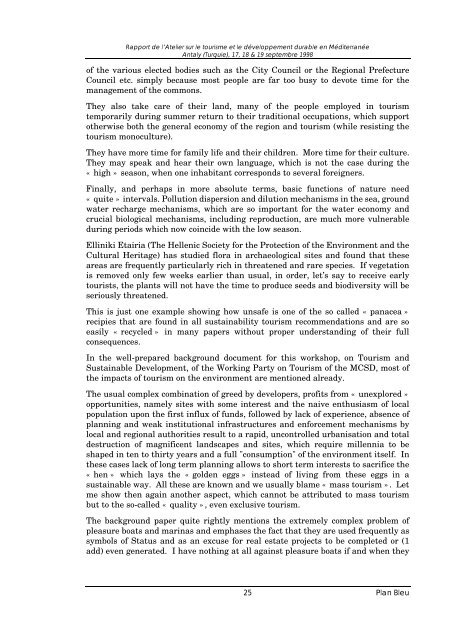MEDITERRANEAN ACTION PLAN
MEDITERRANEAN ACTION PLAN
MEDITERRANEAN ACTION PLAN
You also want an ePaper? Increase the reach of your titles
YUMPU automatically turns print PDFs into web optimized ePapers that Google loves.
Rapport de l’Atelier sur le tourisme et le développement durable en Méditerranée<br />
Antaly (Turquie), 17, 18 & 19 septembre 1998<br />
of the various elected bodies such as the City Council or the Regional Prefecture<br />
Council etc. simply because most people are far too busy to devote time for the<br />
management of the commons.<br />
They also take care of their land, many of the people employed in tourism<br />
temporarily during summer return to their traditional occupations, which support<br />
otherwise both the general economy of the region and tourism (while resisting the<br />
tourism monoculture).<br />
They have more time for family life and their children. More time for their culture.<br />
They may speak and hear their own language, which is not the case during the<br />
« high » season, when one inhabitant corresponds to several foreigners.<br />
Finally, and perhaps in more absolute terms, basic functions of nature need<br />
« quite » intervals. Pollution dispersion and dilution mechanisms in the sea, ground<br />
water recharge mechanisms, which are so important for the water economy and<br />
crucial biological mechanisms, including reproduction, are much more vulnerable<br />
during periods which now coincide with the low season.<br />
Elliniki Etairia (The Hellenic Society for the Protection of the Environment and the<br />
Cultural Heritage) has studied flora in archaeological sites and found that these<br />
areas are frequently particularly rich in threatened and rare species. If vegetation<br />
is removed only few weeks earlier than usual, in order, let’s say to receive early<br />
tourists, the plants will not have the time to produce seeds and biodiversity will be<br />
seriously threatened.<br />
This is just one example showing how unsafe is one of the so called « panacea »<br />
recipies that are found in all sustainability tourism recommendations and are so<br />
easily « recycled » in many papers without proper understanding of their full<br />
consequences.<br />
In the well-prepared background document for this workshop, on Tourism and<br />
Sustainable Development, of the Working Party on Tourism of the MCSD, most of<br />
the impacts of tourism on the environment are mentioned already.<br />
The usual complex combination of greed by developers, profits from « unexplored »<br />
opportunities, namely sites with some interest and the naive enthusiasm of local<br />
population upon the first influx of funds, followed by lack of experience, absence of<br />
planning and weak institutional infrastructures and enforcement mechanisms by<br />
local and regional authorities result to a rapid, uncontrolled urbanisation and total<br />
destruction of magnificent landscapes and sites, which require millennia to be<br />
shaped in ten to thirty years and a full "consumption" of the environment itself. In<br />
these cases lack of long term planning allows to short term interests to sacrifice the<br />
« hen » which lays the « golden eggs » instead of living from these eggs in a<br />
sustainable way. All these are known and we usually blame « mass tourism » . Let<br />
me show then again another aspect, which cannot be attributed to mass tourism<br />
but to the so-called « quality » , even exclusive tourism.<br />
The background paper quite rightly mentions the extremely complex problem of<br />
pleasure boats and marinas and emphases the fact that they are used frequently as<br />
symbols of Status and as an excuse for real estate projects to be completed or (1<br />
add) even generated. I have nothing at all against pleasure boats if and when they<br />
25<br />
Plan Bleu
















